 Is the likely more limited food supply at your home inspiring more culinary creativity during the COVID-19 pandemic? Many people are struggling with how to stretch what is in their own pantries as they may face diminshing options for nutritional support. In fact, one in seven Americans — 46 million people — rely on local food banks and meal service programs to feed themselves and their families, according to a recent study. The COVID-19 pandemic has created particular urgency to meet nutritional needs since local communities may have more difficulty in helping to feed their neighbors. Please consider donating to your local food bank to help support people near you. For example, I have been working with my family to provide our local food pantry with weekly donations of bags of groceries the food bank requested to help fulfill local needs. We also have been providing brown bag meals for a local community center serving highly vulnerable residents. Your community may offer something similar, or you can start your own effort by collecting donations in a box outside of your house/apartment, bringing shelf stable goods to your local food pantry, or maybe checking out local food bank websites for other ideas to help. There are also a lot of national groups that may need aid as we look for ways to help others in this time of such urgent need. Let us help each other get through these stressful, uncertain times as best we can!
0 Comments
While many of us have been social distancing to minimize the chance of infection during the COVID-19 pandemic, this does not mean that we are completely safe from contracting coronavirus. Even if you choose grocery pick-up or delivery instead of physically shopping at the stores, there is still risk of getting coronavirus from others handling the groceries before they get to you. Sanitizing your groceries is essential to protect your safety. This video that was recently shared with me provides an excellent, thorough overview of how to safely handle groceries during this outbreak. It contains food safety tips, which can be very helpful in continuing to minimize your chances of getting coronavirus. I highly suggest that you take a moment to check it out as a great way to stay safe. Since the COVID-19 outbreak, schools across the United States have closed, bars and restaurants have shut down or reduced their services, and many social events have been canceled or postponed. While these changes to promote social distancing are hopefully temporary, COVID-19 has caused many Americans to feel scared and uncertain about the future. As we are becoming increasingly encouraged to socially isolate ourselves as much as possible, you may have found yourself, as well as many others around you, stocking up at local grocery stores to prepare for the unknown. Some of you may cook a lot, while to others the reality of cooking so many in-home meals may feel overwhelming. If you're wondering what to do with this food to maintain variety and enthusiasm over time, below are some inexpensive, easy, and quick ideas for cooking breakfast, lunch, and dinner to inspire you and those who may be isolated along with you. **All recipes make one serving unless otherwise stated.** Breakfast  NUTRITIOUS BREAKFAST SANDWICH Ingredients 1. 2 skinny bagel halves, type of choice (for a healthier option, you may substitute for Ezekiel bread) 2. 1 slice of tomato 3. 1/3 of an avocado 4. 1 egg 5. A pinch of salt Instructions 1. Toast the two skinny bagel halves in a toaster for around three minutes, or until they look slightly golden. 2. Scramble one egg. 3. Using a knife, thinly slice the avocado. Place avocado on the bottom bagel half, and spread around gently. 4. Sprinkle on a pinch of salt, then place the tomato slice, then the scrambled egg, on top. Finally, close the sandwich with the top bagel half. Enjoy! HEALTHY EGG-IN-A-HOLE TOAST Ingredients 1. 1 slice of whole grain bread (healthier choice: Eziekel/sprouted bread) 2. 1 tbsp butter (optional) 3. Egg whites 4. Vegetable of choice (recommended: finely chopped broccoli) 5. A pinch of salt Instructions 1. Cut a circle in the middle of the slice of bread, allowing approximately an inch of bread surrounding the empty circle. 2. Add the optional butter to a medium saucepan, or simply spray some olive oil on the pan. Once melted, place the slice of toast in the pan. 3. Once one side of the bread is slightly golden, flip the slice. In the hole, add your vegetable of choice and the egg whites on top. Once the egg whites harden and form, flip the bread once more. Once the egg whites have totally formed, sprinkle on a pinch of salt, and the toast is ready to serve. Enjoy! Lunch/Dinner 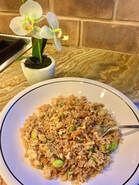 HOMEMADE "FRIED" RICE Ingredients 1. 1 cup white long grain rice (most authentic) or brown rice (healthier) 2. Vegetables of choice (suggested: broccoli, carrots, peas) 3. Sesame oil 4. 1 egg 5. Soy sauce 6. Green onions (optional) Instructions 1. Pour sesame oil into a skillet and turn the heat to medium-high. Add the vegetables and cook until tender. 2. Beat the egg. Then, push the vegetables to the side of the skillet, and on the other half scramble the beaten egg. Stir to incorporate. 3. In a small pot, boil 1 cup of water, then add 1 cup of rice. Cook until all water evaporates. 4. Combine the rice with the egg and vegetables. Stir, add the desired amount of soy sauce, and stir again. 5. Once the fried rice mixture is heated throughout, add the optional garnish of thinly sliced green onions. Serve and enjoy! source: https://therecipecritic.com/easy-fried-rice/ SPRING PESTO PASTA (serves 6) Ingredients 1. 1 lb pasta noodles of choice 2. 1/2 cup basil pesto 3. 1/4 cup finely chopped chives 4. Zest from 1 lemon 5. 1/3 cup mozzarella cheese, cut into cubes 6. 1/4 cup grated Parmesan cheese Instructions 1. Boil salted water in a large pot, then add the pasta. Cook for 11 minutes, or until the pasta is of an al dente form. Next, drain the pasta, leaving about 1/4 cup of water in the pot. 2. Pour the noodles into a large bowl, add the pesto, and stir to combine If the pesto is too thick, add the leftover cooking water in small increments until the sauce is of the desired consistency. 3. Add in the mozzarella, lemon zest, and chives to the large bowl of pasta and stir to combine. 4. Divide up the pasta into bowls and add a Parmesan garnish on top. Enjoy! source: https://www.aheadofthyme.com/spring-pesto-pasta-with-asparagus-and-chives/ Dessert DELICIOUS POACHED FRUIT Ingredients 1. Apples (1/2 apple per person served) 2. Pears (1/2 pear per person served) 3. Cinnamon 4. Dark chocolate chips 5. A splash of milk Instructions 1. Cut the apple and pear into slices about 1/2 an inch thick. Then, place the slices larger side down in a large saucepan or two. Turn the heat to medium. 2. Once the apple and pear slices seem partially tender, flip them over and add a sprinkle of cinnamon onto each surface. 3. Once the apple and pear slices are tender throughout, flip each slice back onto their original sides. Add another sprinkle of cinnamon each, and plate the slices. 4. Melt the desired amount of dark chocolate chips with a splash of milk in the microwave. Depending on how many dark chocolate chips were added, this may take 30 to 60 seconds, or until the chocolate chips are soft. Remove mixture from microwave, and stir until smooth. 5. Dip the poached apple and pear slices with the warm dark chocolate dipping sauce you just made, or drizzle the sauce on top of the fruit. Enjoy! MICROWAVE OREO MUG CAKE
Ingredients 1. 2 tbsp white chocolate chips 2. 10 Double Stuf Oreos 3. 1/2 tsp baking powder 4. 1/2 cup milk 5. Whipped cream (optional) Instructions 1. Microwave the milk and white chocolate chips in a mug for 30 seconds. Stir til smooth. 2. Fill a Ziploc bag with the Oreos. Seal the bag, and crush the Oreos with a rolling pin. Set aside 1 tablespoon of the crushed Oreos for the final garnish. 3. Pour the crushed Oreos and the baking powder into the mug with the milk and white chocolate chip mixture. Stir everything together, and microwave the mixture for 2.5 to 3 minutes on high. 4. Remove the mug from the microwave, and garnish the mug cake with whipped cream and the tablespoon of Oreos you set aside earlier. Enjoy! source: https://www.popsugar.com/food/Microwaveable-Oreo-Mug-Cake-42876397 "Blue Zones" describe several areas across the world where people tend to live significantly longer than the average global life span, with high rates of nonagenarians and centenarians (who live until their 90's and 100's, respectively). Oddly enough, these people may not be particularly lucky genetically. In fact, the most significant explanation why individuals in these areas tend to live longer is their lifestyles. Some of the most prominent Blue Zones include Icaria, an island in Greece; the Ogliastra region of Italy; Okinawa, Japan; and the Nicoya Peninsula of Costa Rica. So, what's the secret to living a long life? In turns out that even if you don't live in a Blue Zone, you may be well on your way to increased longevity by following some smart eating principles that those in Blue Zones use. There are some clear patterns between the eating and culinary styles of individuals living in Blue Zones that may be important contributors to the fact that in these areas ten times more people exceed 100 years of age than in the United States. 1. 95% plant-based diet Blue Zone residents eat meat, on average, only five times per month. This has been shown to minimize the risk of cancer and heart disease. What's more, the benefits of eating a diet rich in fruits and vegetables include an abundance of vitamins and minerals that fuel bodily functions such as the sustaining of your immune system and healing of wounds, among hundreds of others. 2. Hunger reduction People living in Blue Zones tend to eat a high amount of legumes, nuts, and whole grains, all of which are rich in fiber. Fiber keeps us full for longer, so reduces cravings to consume additional calories, sugars, and fats. Another easy way to reduce hunger is to eat slowly, because it allows our body to digest the food over a longer period of time and keeps signals that our stomachs are empty at bay. 3. The 80% rule Many citizens of the Blue Zone of Okinawa, Japan follow "hara hachi bu," a rule in which they stop eating when they feel 80% full rather than 100% full. They believe that the reduced calorie consumption prevents weight gain and chronic disease, both of which often decrease longevity. 4. Intermittent fasting Studies have proven fasting to be an effective means of lowering cholesterol, blood pressure, and risk of chronic disease. The most common fasting schedules are blocking off a few hours per day or one or two days per week in which you don't eat. While some people additionally abstain from drinking water during this no-food period, it may be healthier to regularly drink water as it maintains the balance of bodily fluids, energizes muscles, and helps your kidneys and bowels function. 5. Opt for red wine When selecting alcohol to drink, red wine may be the best choice in terms of longevity. The antioxidants from red grapes prevent the DNA damage that can accelerate aging. Additionally, studies show that those who drink five ounces of red wine per day for at least six months have lower blood sugar and blood pressure, and better cholesterol levels. 6. Breakfast is crucial Research shows that consuming more calories earlier in the day and less later on can reduce the risk of heart disease and can be beneficial to weight loss efforts. Would you like some recipe help? Below is a link to 10 popular breakfast recipes in Blue Zones that are part of the key to unlocking the increased longevity they have discovered. I also recommend exploring the website, beyond the page I have linked, as it goes in greater depth as to the culinary and lifestyle secrets that have helped to give rise to these Blue Zones where the life expectancy is so much higher than the global average. https://www.bluezones.com/2018/06/best-breakfast-ideas-for-eating-breakfast-like-a-king/ Picky eaters are all around us, and even more of us are faced with the dilemma of trying to convert these closed-minded food-yuckers into people who are more open about what foods they try and enjoy. It may seem that no matter what we may do, kids will only resist. From my current job working at a cooking school with extensive focus on children’s programming, I’ve seen firsthand that even the pickiest eaters can be won over using some simple strategies to encourage kids to be a little more open-minded when it comes to eating healthier. A general approach that you're not the child's coach, you're a team, may make a world's difference. Many times picky eaters like to play tug of war -- meaning however hard you pull, they will try to pull back harder. It's important they understand that you are working together, and that healthy food isn't such a foreign, yucky thing. Teamwork, space, and flexibility are key components of a general mindset to have when attempting to open a child's mind to eating right, and becoming less reliant on those sugary cereals and Happy Meals. Additionally, there are some specific approaches detailed below that when utilized, can have a great impact on kids in broadening their culinary horizons. Lead By ExampleFrom a young age, kids are trying to learn what they like and what they don't, and a common method they use to try to figure this out is by observing the preferences of the people around them. Many children idolize the adults in their lives as role models. My suggestion? Use that to your advantage. Instead of telling a picky eater that he or she they might find a unique food yummy if they try it, show the eater it can be yummy by trying it yourself and smiling. Stubborn children might not usually take adults' words for something, but are young enough to not perceive the social cues that would allow them to detect any form of sarcasm (and likely won't until age 10). If you show the child you like the food with pleasant reactions, they have concrete evidence that maybe it isn't so bad. And if children look up to adults in their lives, which most do, they'll be more likely to follow by example. This method isn't foolproof, but it may increase the chances of converting a picky eater into a more open-minded one and encourage them to try new things. Leading by example is a strategy that might might work much better, however, with another one of the following methods. And in the case that this doesn't work well, here’s another idea: think of someone the picky eater idolizes, perhaps a celebrity. Suggesting that their favorite sports player eats broccoli every day to be big and strong might give a helpful nudge in the right direction! Behavioral Learning
When most parents are dealing with picky eaters, they may not consider which of these four methods they use to shape behavior. When the persuaders tell them that they will take something of value away, perhaps their phone or tablet, to get them to try different foods, they are using negative punishment. Many people also attempt to convert these picky eaters to more open-minded eaters by yelling at the kids to stop refusing new foods (positive punishment). These persuaders may find that these methods work in the moment, but will not make a lasting impact in the long run. Positive reinforcement, however, has proven to be much more effective. Instead of threatening to take away dessert or other foods the picky eater likes, instead adults should not make a dessert an initial option but offer it to the children who are willing to step outside of their comfort zone and eat their veggies. Why would encouragement work better than punishing a child for being a picky eater? Younger brains are more active after receiving positive feedback, which gives psychological motivation to succeed. It is easier for them to process encouragement. Also, punishment crushes the autonomy children explore at that age and dissuades exploration of one's preferences. Besides, it is far better to teach kids what to do instead of what not to do, thus it is much easier for them to learn what behaviors are specifically desired. The Control DilemmaAt this stage in their lives, younger kids may want to explore how they can exercise their control to get what they want. This may make it difficult to reason with them, since the typical child seems to make food-based decisions on what he or she thinks they want, not what may necessarily be healthiest. Since kids can be stubborn when it comes to even the lightest suggestion of what to eat and how much of it, it may be best to make them think they are the ones choosing, although there is some sense of adult control. Perhaps, if you want them to eat some veggies, instead of serving up steamed carrots and telling them to eat them because you said so, it would be more effective to give the illusion that they're the ones in control by offering three different prepared vegetables and emphasizing that they get to pick whatever looks the most yummy. They will still feel as if they're in charge, and be less likely to say "NO" and refuse eating the veggies. Not even having some unhealthy food options in the house to begin with will also help, since the kids won't open the pantry and beg for junk food like sugary cereals. Looks Can Mean EverythingBe creative with how you prepare food! Fruits and veggies may seem boring to young kids who are constantly seeking ways to stimulate their imagination. Plus, from an evolutionary perspective, humans may prefer red, orange, and yellow food coloring which indicates that a food source is ripe (most of the time). This may make us more hesitant of bright purple and bright blue food dyes, so I suggest leaving the fruits and veggies their natural color. What can be done to make a meal look more interesting, however, is to create color contrast with the food. A variety of vibrant hues makes for a pretty plate, and, after all, our taste perceptions can actually be altered by our visual perceptions (for more, see the concept of visual capture). Making healthy food into fun shapes can also be exciting for picky eaters. If their favorite animal is a fish, take out some cookie cutters and make their watermelon into fish, that swim in carefully arranged blueberry "water!" This makes eating a more engaging experience for the child and helps them build a stronger association between healthy food and positive memories and emotions. The last thing that can make food look better and therefore possibly taste better is the execution. Attention to detail is crucial, and kids like to feel more grown up if they are served food that looks more "adult." Think of topping vegetables with a drizzle of sauce or a sprinkle of sesame seeds. Perhaps lay some fruit slices on top of a cinnamon heart. Consistent cuts and placement will surely make the food look prettier. Consider the three concepts of color contrast, shape, and execution when preparing and plating healthy food and perhaps kids will be more likely to try a bite of this engaging experience. Maintain Clear ExpectationsKids can hang on to every word you say. Most seem to have a remarkable memory for when they feel like you've gone back on a promise or your word, and can get extremely upset. Also, telling them plans last minute can stress them out as kids can be inflexible and let their emotions take over rational thinking. Therefore, to minimize children associating food and eating with negative emotions, it is recommended that expectations are made clear ahead of time. Growing up, I always had to try one bite of everything served to me. Eating the rest of the portion was up to me, but by having to try everything I was exposed to foods I never would have otherwise sampled. By making this a consistent rule, tantrums were immensely minimized. With inconsistent rules, across different meals or perhaps across different children, the word "fair" likely becomes the food-related argument's central topic. What would clear expectations look like, exactly? They can range from setting rules about meal schedules and quantities of certain foods, to expectations of how often kids help out in the kitchen. Although initial pushback is expected, once a routine is established children would be more likely to follow the food rules. Hopefully, you are now better informed on how to work with picky eaters in order to encourage them to become more open-minded when it comes to food-based decisions and healthier options. It's important to make sure kids are as involved in the choosing process and feel as if their opinion is valued as much as possible, while still maintaining an underlying level of control. When kids are involved in the process, whether by helping to make their meals (helps associate healthy food with fun) or by making a final choice when presented with a few options you prefer, it helps them to be more interested in this healthy food.
All in all, when it comes to picky eaters, be a team, and make healthy food interesting. The magnitude of their newfound passion for eating "right" may astonish you. It’s the end of summer, and most athletes are looking towards the upcoming competition season. In order to make sure that both the team and individual players are the strongest they can possibly be, most coaches emphasize proper training in order to give athletes the boost they need to be as prepared as possible. However, one thing that coaches may neglect when considering how to strengthen their team or trainees is proper nutrition. There are a lot of eating habits that athletes may not realize hinder their performance or otherwise reach their full potential. What an athlete consumes has a major effect on performance. Even small changes to what someone eats can improve his or her athletic ability, and give an athlete a competitive edge. Carbohydrates One of the most significant changes athletes can make to their diets to keep their energy up and help recovery is to cut out most processed foods, especially sugars. Eating a lot of processed carbs does cause an energy spike, but leads to a sudden crash whereas eating real, simple sugars sustains energy levels. Some examples of great simple carbs that maintain an athlete’s energy include quinoa, rice, oatmeal, sweet potato, fruits, and vegetables. However, foods packed with complex sugars, such as Pop-Tarts, candy, chips, cereal, and especially soda should be avoided whenever possible. Mr. Sullivan, health teacher and coach of the Deerfield High School (DHS) boys and girls swim teams, is a strong believer in consuming natural, real carbs to maximize endurance. “Processed sugars are huge in terms of hurting an athlete. If you can go to a [processed] sugar-free diet or consume a very small amount of sugar, I’d say after two weeks you’re gonna start noticing a difference in energy level and sleep patterns. Your muscles and body will feel much better, and after a month you will wonder why you were ever eating sugar,” he explains. Protein Unlike natural sources of protein, synthetic proteins (like those found in most energy bars) pass straight through one’s body and are not as efficiently stored to power muscle use. “I think that eating meats or eggs is going to be better for you than a synthetic protein,” agrees rigorous powerlifter Caleb Saks, a senior at DHS. Sullivan also advises that it is better to consume natural proteins as opposed to grabbing a protein bar before practice. Those are typically high in processed sugar to preserve taste, and include ingredients that impact the body in ways that an athlete may not be fully aware of. It is better to eat simple, real foods where it is known exactly what is in it, there are as few ingredients as possible, and the impact on the body of each ingredient is known and positive. Protein bars are quick and easy, which is why many choose to grab a Cliff or Gatorade bar before practice. However, there are bars out there that have ingredients that are not processed, and still provide necessary protein. An example of a bar, for instance, that is both tasty and is made of simple carbs and proteins, is a Blake’s bar. It includes nuts and seeds which contain the protein needed to fuel muscle strength and recovery with the benefit of natural ingredients to maximize protein storage efficiency. However, while it is important to eat a lot of protein to gain muscle, Sullivan warns to beware of overconsumption. If there is too much protein for the body to process, the excess can block the main arteries. Keep in mind that the ideal amount of protein that each individual should consume varies; there is no “right” amount that everyone should eat. Supplements The bottom line is: they aren’t necessary. Some athletes take creatine — a chemical compound found in many types of red meat. However, it is better to eat red meat itself than the creatine supplement. The supplement has potential side effects including stomach pain, muscle cramping, and nausea that are less likely to occur if it is consumed in its natural form found in red meat. If an athlete has a proper, balanced diet, supplements are not needed to maintain performance. Caffeine According to Saks, sipping a little coffee before he works out is helpful. Although on the surface it may seem like drinking caffeine before a workout would not have any major benefits, athletes who do so may be on to something. Those sips of coffee get someone’s heart rate in the working zone faster, shortening the warm-up time before an athlete’s heart rate can get to the point where the workout will have an impact. While a little coffee can be beneficial, however, too much of it can impair sleep and cause muscle tremors among other aversive health effects. Essentially, there is no “cheat code” for how to become a better athlete faster; it is a mixture of training and proper nutrition. Too much of anything is unhealthy, so a balanced diet with real, simple foods is critical to an athlete reaching peak performance. That isn’t to say that an athlete should never indulge in candy, chips, or Gatorade. It’s unrealistic to not be able to indulge once in a while, but cutting back on complex proteins and carbs will help to improve muscle gain, energy level, and recovery rate immensely. These small eating tips can amount to a major change, and, may be the advantageous edge an athlete needs to succeed. When you walk into a supermarket, you are surrounded by thousands of options, yet you only choose a fraction of what's presented to you. What do you find most appealing about the products that end up in your cart? Maybe you don't know, and if you think you do know, chances are there are many more factors that are pulling you in than you are aware of. The food industry is particularly clever. Every single decision made -- from grocery store layout, colors used in packaging, a brand logo, etc. -- is meant to pull you in a specific direction. Every decision made in the food industry, even in grocery store layout, however minuscule, has an impact on what you buy and how much of it. For instance, have you ever considered how most grocery stores have the entry doors on the right side? Think about it. It's weird, right? Maybe it's a coincidence. Although, research shows most shoppers prefer to shop in a counter-clockwise fashion, which is why grocery store entrances are normally on the right and checkout counters are normally on the left. This example -- along with many others -- shows how we can be subliminally swayed in food-based decisions. Stick with this post to uncover some of the ways you are being persuaded that you likely are not aware of so that you can become a better informed consumer, and save time and money. What was your last impulse buy, and why did you purchase it? Comment below! As we wrap up 2018, we remember the numerous notable events that occurred in the food industry this year. Romaine lettuce was recalled not once but twice, highly influential chefs Anthony Bourdain and Paul Bocuse passed away, the FDA released a healthier new food code, and much more. Not only were there many significant things that occurred, but there were a few significant trends that came into play in 2018. Below are a few key findings... 1. Picky eaters? Millennials, a generation of adults that is on the rise, go out to eat more often than members of Gen X or Baby Boomers. One may think restaurants' growing popularity would lead to there being more of them, but as of May 2018 the number of restaurants had actually dropped 3 percent from a year prior. Maybe consumers are just being more picky and exploring less dining choices. 2. Destination-specific cuisine In 2018 more consumers wanted to dine at restaurants and purchase food that aligned with a specific part of the world's unique cuisine. It seems that people don't want food options that are as general, like food such as rice which is present in many cuisines, or are maybe just more open to receiving experiences that you would only get if you traveled (transportation such as flying has become too expensive for some). 3. Restaurants that are more open to sharing What I mean by this is that seemingly more and more menus contain nutritional information such as what items are gluten free, vegetarian, or vegan, and how many calories each dish has. Additionally, I have noticed that new or remodeled restaurants are increasingly containing glass walls so that customers can see into the kitchen or view the ingredients that they are using. Perhaps these restaurant trends are to fit what they perceive is the consumer trend of being more curious of what they are putting into their bodies. 4. "Lazy" dining DoorDash, which was founded in 2013, is now the 162nd most popular and 155th most famous website online, out of 644 million websites in existence. According to prestigious news sources such as Forbes, USA Today, and the LA Times, food delivery is on the rise while less people are visiting restaurants. Perhaps this is due to shifting values, and Americans today are becoming more obsessed with this form of convenience. Especially for those who lead busy lives, "lazy" dining is surely more preferable since it is quick and easy. 5. Diverse buffets Restaurants are increasingly turning towards buffets due to their appeal for those in a rush, those who don't want to spend as much money, and those who enjoy choices (well, who doesn't?). The reasoning is simple. Buffets---> more customers---> more money. And what restaurant doesn't want more money? However, as a new year begins new trends will come into play. The wants and needs of consumers are always changing, and 2019 will be no exception. Due to foods/restaurants that started to become more popular in late 2018, there are a few key trends that can be predicted to take shape this year. Get ready to stock those shelves! 1. Spicy products Consumers are always looking for daring new foods to try, and like to challenge themselves constantly. According to the Kalsec HeatSync Heat Index, the new global products that have been introduced have become increasingly more spicy across more than a decade. I expect this index will continue to rise, and in 2019 we will see more new foods with a little kick than ever before. 2. Mexican-style restaurants As the progress of Chipotle's success has slowed and declined (has gone through several CEOs in the past few years, closed 65 under-performing restaurants last June), this has created opportunity for new spins on Mexican food to enter the restaurant world. Not to mention, the increasing Hispanic population in the U.S. will thus create more consumers and producers of foods following Mexican cuisine, growing the industry further in 2019. 3. Innovative proteins This is not a prediction, this is practically a guaranteed trend that will continue to rise in popularity in 2019. One of the main innovative practices in the food industry has recently been creating unique protein products from plants and even insects! This has even made its way into my house, and we find ourselves eating plant-based burgers (we are vegetarian) every other week, and they taste eerily similar to normal burgers. Science has advanced to the point where we are receiving more and more options for our protein, and the food industry is starting to think out of the traditional box where consumers turn to animals for the bulk of their protein consumption. (Those are the trends that I believe will soar in 2019, in addition to a few trends from 2018 that will continue across 2019 such as the Paleo diet, healthier desserts/snacks, and food in bowl format.) 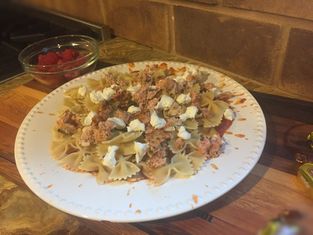 Tired of the same spaghetti, bowtie pasta, or easy mac and cheese? These classic pastas are easy to make, which is perhaps why we cook them so often. However, these three types of pasta are simple and lack creativity, so it can get boring to keep making the same types of pasta! We need our carbs, but I've recently been asking myself (as I'm sure you have too), are there more exciting, original ways to get our carbs in a healthier way? So, this question led to some thinking and experimentation. I've been investigating some new ideas to make pasta more nutritious and more interesting. In the process I've discovered some suggestions that I think you will find helpful the next time you make pasta, just as I have! Recipe #1 Ingredients (although may seem like a strange combination, work together really well!): - Bowtie pasta (brand: Barilla Protein Plus) - 1 salmon burger - 1 can of tomato soup - Cream cheese Directions: 1. Boil the amount of water specified on pasta box in a medium pot, then pour in pasta. 2. While the pasta cooks, in another pot heat up the tomato soup. In between the occasional stirring of the soup and the pasta, grill/microwave the salmon burger. 3. When the pasta is slightly al dente (you should know by biting into it, since you would see a thin strip of white in the center of the noodle) turn off the heat and pour it into a strainer. 3. Pour 1/2 of the hot soup on the plate, then pour the pasta on top. Drizzle a bit more soup on top, then crumble the salmon burger on top of that. Finally, dole out small scoops of cream cheese and spread out evenly throughout the pasta so they melt a bit. And now, you can enjoy! What to take away from this recipe... - Yes, there are types of noodles that have extra protein inside, such as Barilla Protein Plus bowties! A great way to boost protein, and I recommend that brand in particular because it still tastes like normal pasta :) -Don't feel like putting your energy into whipping up a flavorful sauce, and finding all the perfect spices for it? Substituting soup instead will save you the hassle! -Did you read that right? I told you that you should put cream cheese on pasta? Well yes, that is not a joke or trick to see if you were paying attention. Parmesan, move aside, because cream cheese is actually excellent on most types of pasta. It's what I call a connector, it brings together the flavors and/or textures of other ingredients and enhances them. While putting cream cheese on top of your next pasta could be uncharted territory for you, great dishes are never played safe, so I urge you to try it! 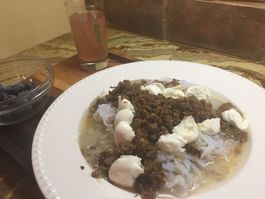 Recipe #2 Ingredients (again, may seem like a strange combination but surprisingly works well): - Miracle Noodle angel hair pasta -1 can of mushroom bisque soup (Amy's is my favorite brand of this), not to be confused with cream of mushroom -Taco meat -Small mozzarella balls Directions: 1. Boil the amount of water specified on the package in a medium pot, then pour in the pasta. Cook according to directions on the package. 2. While the pasta is cooking, in a medium saucepan pour some olive oil then add the desired amount of taco meat. Also, in a medium pot heat up the mushroom bisque. 3. When the pasta is finished, drain all the water from it and let it sit until you think most of the moisture is gone. 4. Pour 1/3-1/2 of the soup onto a plate and pour the Miracle Noodles on top. Then, pour the taco meat over it, and finish it off by adding the small mozzarella spheres. And finally, bon appétit! What to take away from this recipe... - What is Miracle Noodle? My new favorite guilt-free pasta! These noodles have no calories, yet all of the consistency and flavor of a real noodle! Perfect for diets, or if you want to reduce your calorie intake. However, they taste a bit bland, which is why they work best paired with intense flavors such as that of the mushroom bisque. -Taco meat isn't just great in tacos, but it's great on pasta! The rich flavor matches that of the mushroom bisque, and contrasts the more bland noodles. -I don't know about you, but the stringy consistency of mozzarella cheese can get old. Choosing more fun shapes for your cheese such as spheres definitely makes it more creative, and fun to eat! I love eggs. I eat scrambled eggs for breakfast every morning, but it gets tiring and boring to just have this simple dish every day. Yes, eggs that are scrambled or fried or hard boiled are quick and easy, but wouldn't exploring other, more creative egg dishes that are just as quick and easy be more exciting? This has inspired me to do some searching for some healthy, delectable recipes involving eggs so that you can get the right start to your day. Below you will find fast, high-protein, and highly tasty options that I have discovered and am now in love with, and I hope you soon will be too!
|
Jessica A.A high schooler with a love of food. See the My Story page to find out more. Archives
June 2021
Categories |
"Time to eat smart."
Food Blog
Email me at [email protected] to let me know what you think!
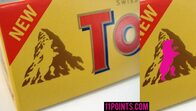

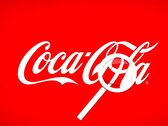




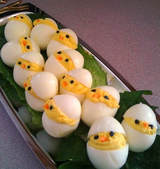
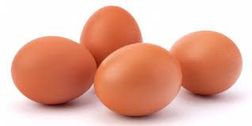
 RSS Feed
RSS Feed